
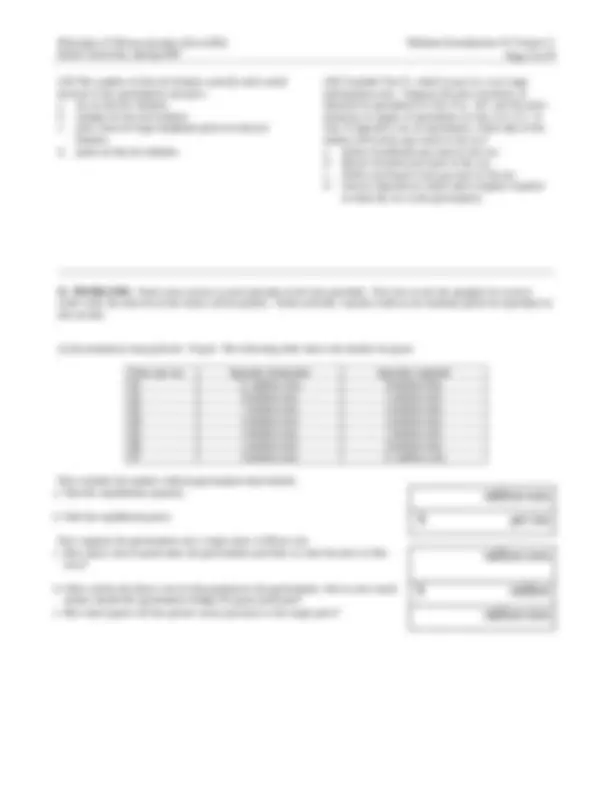
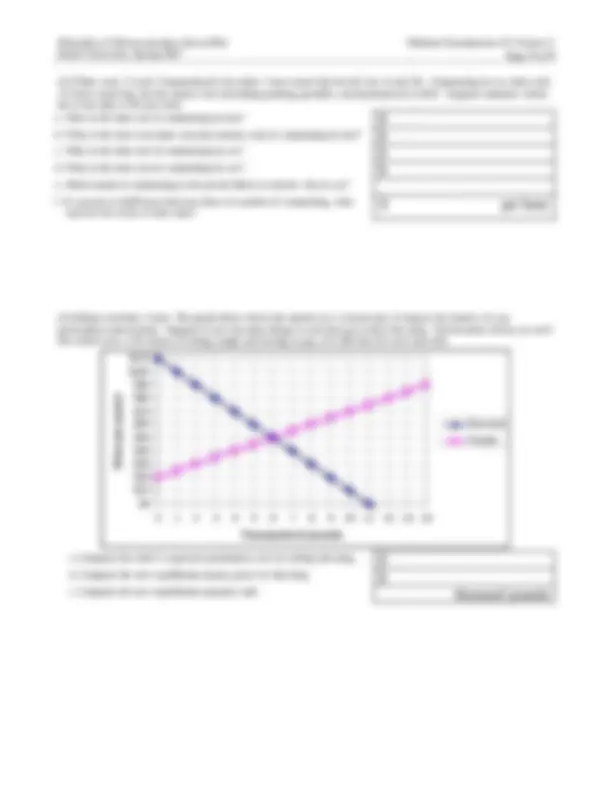
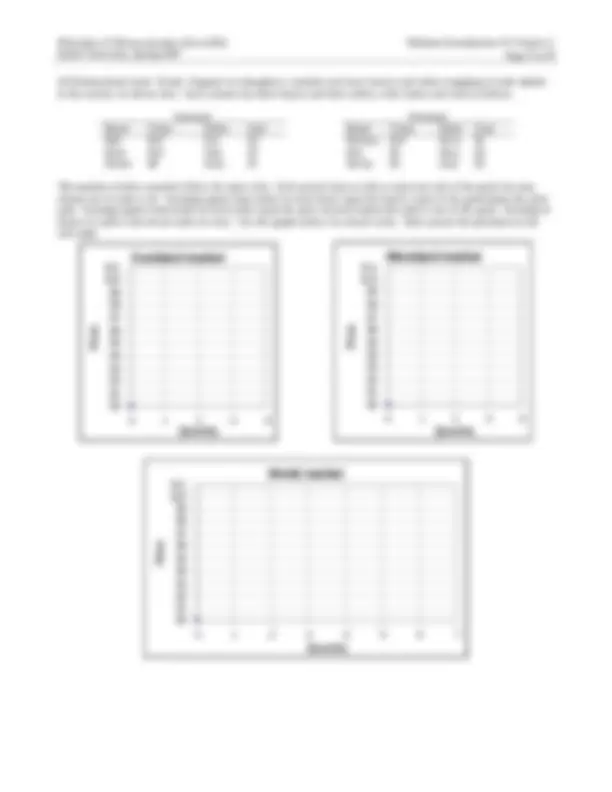
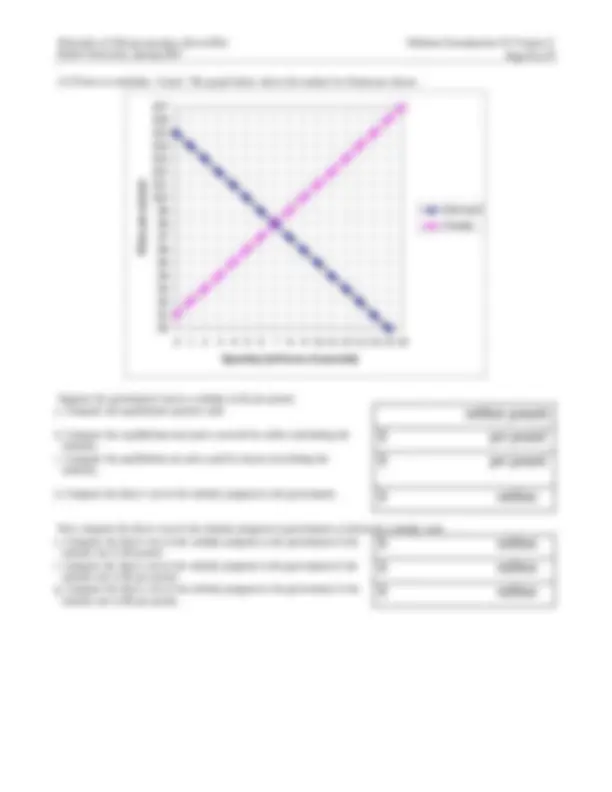
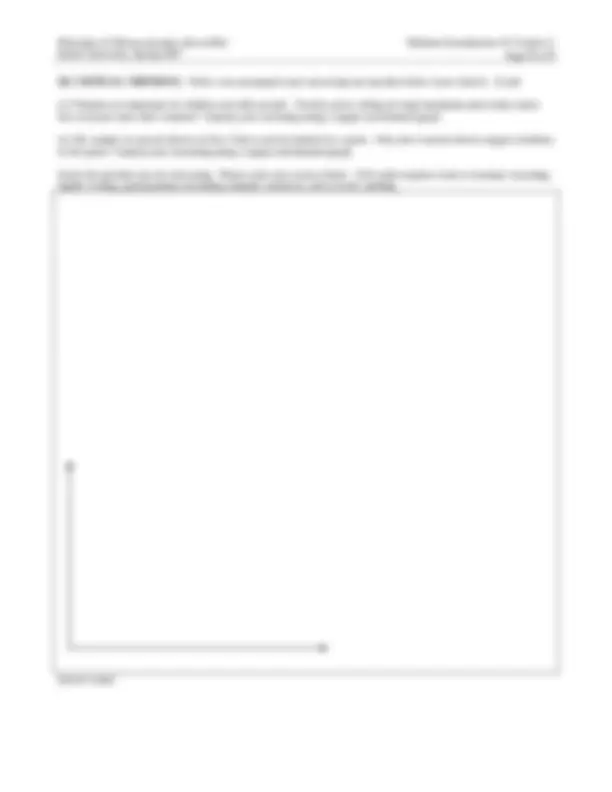


Study with the several resources on Docsity

Earn points by helping other students or get them with a premium plan


Prepare for your exams
Study with the several resources on Docsity

Earn points to download
Earn points by helping other students or get them with a premium plan
Community
Ask the community for help and clear up your study doubts
Discover the best universities in your country according to Docsity users
Free resources
Download our free guides on studying techniques, anxiety management strategies, and thesis advice from Docsity tutors
Material Type: Exam; Professor: Boal; Class: PRINCIPLES OF MICROECONOMICS; Subject: Economics; University: Drake University; Term: Spring 2007;
Typology: Exams
1 / 9

This page cannot be seen from the preview
Don't miss anything!






Principles of Microeconomics (Econ 002) Signature: Drake University, Spring 2007 William M. Boal Printed name:
INSTRUCTIONS: This exam is closed-book, closed-notes. Simple calculators are permitted, but graphing calculators or calculators with alphabetical keyboards are NOT permitted. Numerical answers, if rounded, must be correct to at least 3 significant digits, but fractions are always acceptable answers. Point values for each question are noted in brackets. Maximum total points are 100. I. MULTIPLE CHOICE: Circle the one best answer to each question. [1 pt each, 20 pts total] (1) The word "benevolent" means a. "all-powerful." b. "doing good." c. "all-knowing." d. "benefiting only oneself." (2) If the government wants to raise the price of oranges it should try to shift a. the demand for oranges to the left. b. the supply of oranges to the right. c. both (a) and (b). d. neither (a) nor (b) will raise the price of oranges. (3) Suppose the government buys milk in an effort to raise its price. Which disposal method will not cause the price of milk to fall again? a. Give away surplus milk to consumers. b. Destroy surplus milk. c. Sell surplus milk on the open market. d. None of the above will cause the price of milk to fall. (4) Suppose the government institutes a new, more efficient security system in airports that decreases the time that passengers must spend in the terminal. By itself, this would shift a. the demand for air travel down. b. the demand for air travel up. c. the supply of air travel down. d. the supply of air travel up. (5) Recently, the supply of soybeans in Brasil has shifted right. Since soybeans are traded internationally, this should cause the price of soybeans in the U.S. to a. fall. b. remain constant. c. rise. d. Cannot be determined from information given. (6) Currently, the price of sugar in the U.S. is higher than in other countries, but U.S. restricts international trade in sugar. If free international trade were permitted, the U.S. would a. export sugar. b. import sugar. c. be self-sufficient in sugar. d. Cannot be determined from information given. (7) The prices of many kinds of food are higher in Europe than in the United States. Restrictions on trade in food may be phased out. This change would benefit a. U.S. food producers and U.S. food consumers. b. European food producers and European food consumers. c. European food producers and U.S. food consumers. d. U.S. food producers and European food consumers. (8) Arbitrage causes the prices of the same good at different locations to a. both rise. b. both fall. c. grow closer together, reducing arbitrageurs' profit. d. grow farther apart so arbitrageurs can enjoy higher profit.
Drake University, Spring 2007
(9) Arbitrageurs’ motivation for buying and selling is to a. make money. b. enforce the Law of One Price. c. keep markets orderly. d. ensure that all consumers face a fair price. e. all of the above. (10) Suppose the price of peaches in Georgia is $0. per pound and that the cost of shipping peaches between Georgia and Iowa is $0.10 per pound. The market is in equilibrium if the price of peaches in Iowa is a. $0.35 per pound. b. $0.45 per pound. c. $0.65 per pound. d. $1.00 per pound. e. none of the above—all these prices are out of equilibrium. (11) Arbitrage will not guarantee that people in Iowa and Chicago pay similar prices for a. shares of stock. b. euros. c. houses. d. government or corporate bonds. (12) Suppose for some reason the futures price of petroleum for delivery next December were $60, but you believed that the spot price would be $50 next December. You could make money by a. selling petroleum futures now and selling petroleum on the spot market in December. b. buying petroleum futures now and selling petroleum on the spot market in December. c. selling petroleum futures now and buying petroleum on the spot market in December. d. buying petroleum futures now and buying petroleum on the spot market in December. (13) Speculators buy and hold inventories for resale in the future because they want to a. make money. b. raise the price of a good today and lower it in the future. c. ensure adequate supply for future consumption. d. encourage conservation today. e. all of the above. (14) Speculation through buying and holding inventories will tend to a. encourage conservation today. b. raise the price of a good today and lower it in the future. c. ensure adequate supply for future consumption. d. all of the above. e. none of the above. (15) Suppose the price of a share of stock in Giant Corporation today is $60. We know that speculators are already active in the stock market. Assume that the stock market is in equilibrium. Then speculators must believe that the price of a share of stock in Giant Corporation tomorrow will be a. less than $60. b. about $60. c. greater than $60. d. cannot be determined from the information given. (16) Suppose a certain natural resource in limited supply can be stored at no cost. Assume speculators are active in the market for this resource. In equilibrium, the price of that natural resource is expected to a. fall at the rate of interest. b. shoot up sharply when most of the resource is gone. c. remain constant. d. grow at the same rate of return as alternative investments. (17) The price of gasoline will increase if the government imposes a. a quota on buyers of gasoline. b. a price ceiling (or legal maximum price) for gasoline. c. a quota on sellers of gasoline. d. any of the above. (18) Who benefits from a price floor or legal minimum price? a. All sellers. b. All buyers. c. Some sellers. d. Some buyers. e. All buyers and all sellers. f. No one.
Drake University, Spring 2007
(2) [Time costs: 12 pts] Commuting by bus takes 1 hour round trip but the fare is only $2. Commuting by car takes only 1/2 hour round trip, but the money cost (including parking, gasoline, and maintenance) is $10. Suppose someone values her or his time at $12 per hour.
e. Which mode of commuting is the person likely to choose--bus or car? f. If a person is indifferent between these two modes of commuting, what must be the value of their time?
(3) [Illegal activities: 6 pts] The graph below shows the market for a certain type of drug in the absence of any government intervention. Suppose it now becomes illegal to sell (but not to buy) this drug. Enforcement efforts are such that sellers face a 5% chance of being caught and having to pay a $ 1200 fine for each unit sold. $
Thousands of pounds Price per pound Demand Supply
Drake University, Spring 2007
(4) [International trade: 19 pts] Suppose two imaginary countries each have buyers and sellers engaging in trade similar to the activity we did in class. Each country has three buyers and three sellers, with values and costs as follows. Eastland Westland Buyer Value Seller Cost Buyer Value Seller Cost Bob $10 Sue $2 Barbara $10 Steve $ Betty $10 Seth $7 Ben $5 Sissy $ Bernie $9 Sally $7 Becky $3 Sean $ The markets in both countries follow the same rules: Each person buys or sells at most one unit of the good, but may choose not to trade at all. Earnings (gains from trade) for each buyer equal the buyer's value of the good minus the price paid. Earnings (gains from trade) for each seller equal the price received minus the seller's cost of the good. Earnings of buyers or sellers who do not trade are zero. Use the graphs below for scratch work. Then answer the questions on the next page.
Quantity Price
Quantity Price
Quantity Price
Drake University, Spring 2007
(5) [Price controls: 6 pts] The graph below shows the market for salsa. $
Quantity (millions of bottles) Price per bottle Demand Supply Suppose the government imposes a price floor (or legal minimum price) of $6 per bottle.
b. Will there be excess demand, excess supply, or neither?
(6) [Quotas: 8 pts] Suppose the government wants to limit the use of a certain chemical that is thought to be harmful to the environment by imposing a quota. The market for the chemical is shown in the graph below. $
Thousands of gallons Price per gallon Demand Supply First suppose the quota is imposed on producers , who receive 20 thousand permits to sell a gallon of the chemical.
b. If the government sells the permits to producers at auction, what price will the permits go for at the auction?
Alternatively, suppose the quota is imposed on consumers , who receive 20 thousand permits to buy a gallon of the chemical.
d. If the government sells the permits to consumers at auction, what price will the permits go for at the auction?
Drake University, Spring 2007
(7) [Taxes or subsidies: 14 pts] The graph below shows the market for Parmesan cheese. $
Quantity (millions of pounds) Price per pound Demand Supply Suppose the government enacts a subsidy of $2 per pound.
b. Compute the equilibrium total price received by sellers (including the subsidy).
c. Compute the equilibrium net price paid by buyers (excluding the subsidy).
Now compute the direct cost of the subsidy program to government at alternative subsidy rates. e. Compute the direct cost of the subsidy program to the government if the subsidy rate is $4 pound.
f. Compute the direct cost of the subsidy program to the government if the subsidy rate is $6 per pound.
g. Compute the direct cost of the subsidy program to the government if the subsidy rate is $8 per pound.